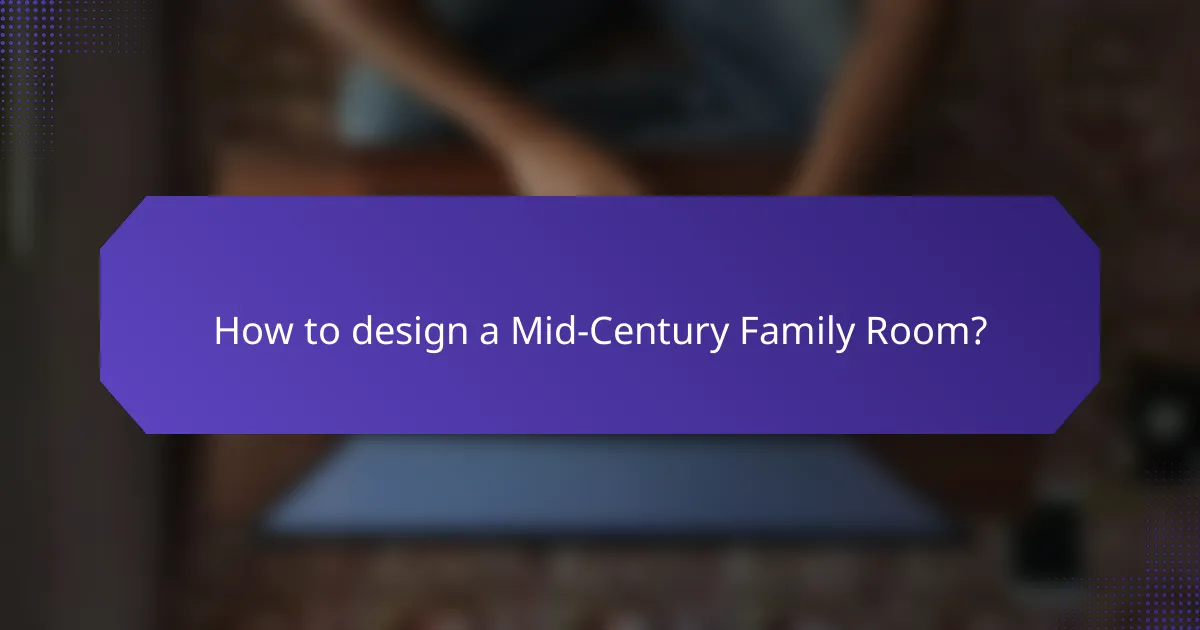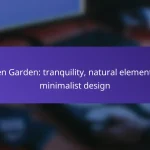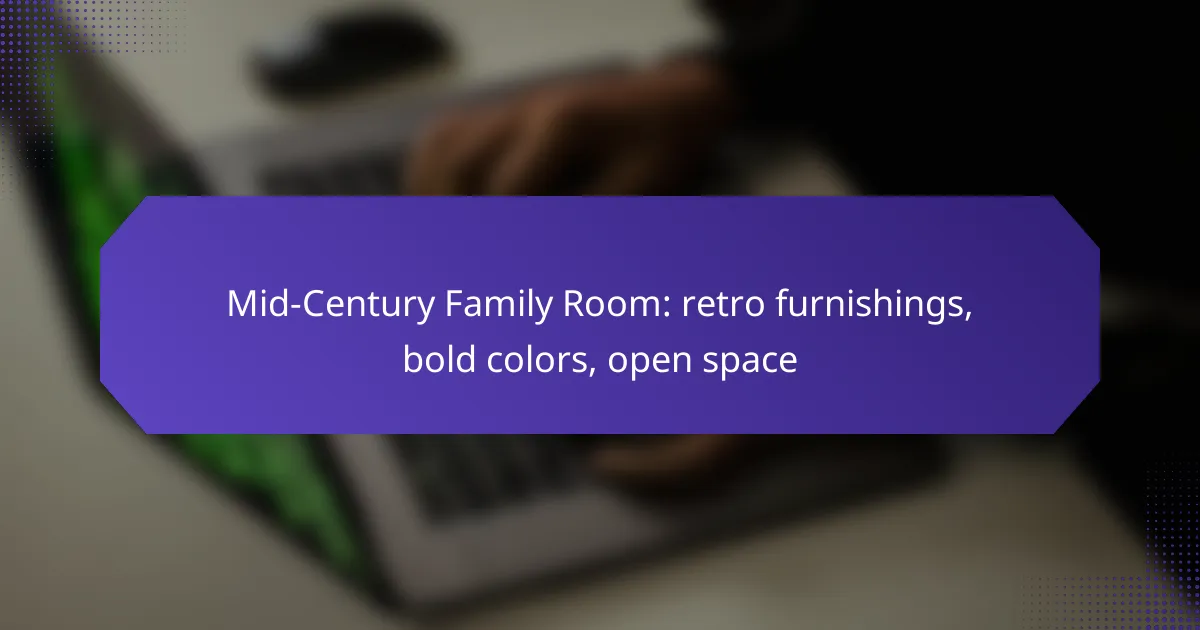Designing a Mid-Century family room involves a harmonious blend of retro furnishings, bold colors, and an open layout that invites both comfort and style. By incorporating iconic pieces from the 1950s and 1960s, you can create a vibrant space that reflects the era’s artistic spirit while ensuring it remains functional for everyday living.

How to design a Mid-Century Family Room?
Designing a Mid-Century family room involves blending retro furnishings, bold colors, and an open layout to create a welcoming and stylish space. Focus on incorporating iconic design elements that reflect the aesthetic of the 1950s and 1960s while ensuring functionality for everyday use.
Incorporate retro furnishings
To achieve a Mid-Century look, select furniture pieces that feature clean lines, organic shapes, and natural materials. Look for items like teak wood coffee tables, low-profile sofas, and accent chairs with tapered legs. Vintage shops or online marketplaces can be great sources for authentic retro finds.
Consider mixing different textures and materials, such as leather, wool, and linen, to add depth to the space. Avoid overly ornate designs; simplicity is key in Mid-Century style.
Use bold color palettes
Bold colors are a hallmark of Mid-Century design, often featuring rich hues like mustard yellow, teal, and burnt orange. Use these colors as accents through throw pillows, rugs, or artwork to create focal points in the room. A neutral base, such as white or light gray walls, can help these vibrant colors pop.
When selecting a color scheme, consider the overall mood you want to create. Pair warm tones with cool shades for balance, and don’t shy away from mixing patterns in textiles for added visual interest.
Maximize open space
Mid-Century design emphasizes open spaces that promote flow and interaction. Arrange furniture to encourage conversation, ensuring that pathways remain clear and unobstructed. Avoid overcrowding the room with excessive furniture or decor.
Utilize multi-functional pieces, such as ottomans that double as storage, to keep the space organized while maintaining an airy feel. Large windows can enhance openness, so consider sheer curtains to allow natural light to flood the room.
Focus on functional layouts
Creating a functional layout is essential for a Mid-Century family room. Start by identifying the primary activities that will take place in the space, such as relaxing, entertaining, or playing games. Arrange furniture to support these activities while ensuring comfort and accessibility.
Use area rugs to define different zones within the room, which can help organize the space without compromising the open feel. Remember to leave enough space between furniture pieces for easy movement.
Choose iconic decor pieces
Incorporate iconic decor pieces that reflect the Mid-Century aesthetic, such as starburst clocks, abstract art, and sculptural vases. These elements can serve as conversation starters and enhance the overall theme of the room.
When selecting decor, prioritize quality over quantity. A few well-chosen items will make a stronger impact than a cluttered display. Look for pieces that resonate with the era’s design philosophy, focusing on simplicity and functionality.

What are the best retro furnishings for a family room?
To create a mid-century family room, focus on retro furnishings that embody bold colors and clean lines. Key pieces include iconic sofas, vintage coffee tables, classic armchairs, and unique lighting fixtures that enhance the open space.
Mid-Century sofas
Mid-century sofas are characterized by their sleek profiles and vibrant upholstery. Look for options with tapered legs and geometric shapes, often in colors like mustard yellow, teal, or burnt orange. These sofas not only serve as a focal point but also provide comfortable seating for family gatherings.
When selecting a sofa, consider the size of your family room. A sectional can work well in larger spaces, while a loveseat may be better suited for smaller areas. Ensure the fabric is durable, especially if you have children or pets.
Vintage coffee tables
Vintage coffee tables add character to your family room and often feature unique designs and materials. Popular choices include tables made from walnut or teak with glass tops, which reflect the mid-century aesthetic. These tables can serve as both functional surfaces and decorative pieces.
When choosing a coffee table, consider its height and size in relation to your sofa. A good rule of thumb is to keep it 12-18 inches away from the seating area for easy access. Look for tables with storage options to keep the space organized.
Classic armchairs
Classic armchairs from the mid-century era are known for their ergonomic designs and bold colors. Pieces like the Eames lounge chair or the Hans Wegner Wishbone chair are timeless options that provide both style and comfort. These chairs can complement your sofa and add additional seating.
When selecting armchairs, ensure they match the overall color scheme of your family room. Mixing and matching different styles can create an eclectic look, but aim for a cohesive palette to maintain harmony in the space.
Unique lighting fixtures
Unique lighting fixtures are essential for enhancing the ambiance of a mid-century family room. Look for iconic designs such as arc floor lamps or Sputnik chandeliers that serve as statement pieces. These fixtures can add both functionality and a touch of retro flair.
Consider the placement of your lighting to create a warm atmosphere. Layering different types of lighting, such as overhead fixtures and table lamps, can help achieve a balanced look. Ensure that the fixtures are not only stylish but also provide adequate illumination for the space.

What color schemes work for Mid-Century design?
Mid-Century design often features vibrant color schemes that reflect the era’s artistic spirit. Key color palettes include bold primary colors, earthy tones, and pastel accents, each contributing to the open and inviting atmosphere typical of this style.
Bold primary colors
Bold primary colors like red, blue, and yellow are hallmarks of Mid-Century design. These colors can be used as statement pieces in furniture or accent walls, creating focal points that energize the space.
When incorporating bold colors, consider using them in moderation to avoid overwhelming the room. Pairing a bright sofa with neutral accessories can balance the vibrancy while maintaining the retro aesthetic.
Earthy tones
Earthy tones such as olive green, mustard yellow, and terracotta are essential for achieving a warm, grounded feel in a Mid-Century family room. These colors evoke a connection to nature, which was a significant influence during the era.
To effectively use earthy tones, consider painting walls in soft shades and complementing them with wooden furniture or natural textiles. This combination enhances the organic vibe while ensuring a cozy atmosphere.
Pastel accents
Pastel accents like mint green, soft pink, and light blue can add a refreshing touch to Mid-Century spaces. These subtle hues work well as accents on smaller furniture pieces or decorative items, providing a gentle contrast to bolder colors.
Incorporating pastel accents can be as simple as adding throw pillows or artwork. This approach allows for easy updates to the decor without committing to larger changes, making it a flexible option for evolving tastes.

How to create an open space layout?
Creating an open space layout involves maximizing the flow and functionality of a room while minimizing barriers. This design approach encourages interaction and flexibility, making it ideal for family rooms.
Use multi-functional furniture
Multi-functional furniture is essential for an open space layout, as it allows for versatility without crowding the area. Consider pieces like sofa beds, ottomans with storage, or coffee tables that can expand for dining purposes.
When selecting furniture, prioritize items that serve more than one purpose. For instance, a bench can provide seating and storage, while a foldable desk can transform a corner into a workspace when needed.
Incorporate area rugs
Area rugs help define different zones within an open space while adding warmth and color. Choose bold patterns or vibrant colors that reflect the mid-century aesthetic to enhance the retro vibe of the family room.
Position rugs strategically to delineate areas, such as placing a large rug under the seating arrangement to create a cozy conversation area. Ensure the rug size is proportionate to the furniture layout, typically covering the front legs of sofas and chairs.
Designate activity zones
Designating activity zones is crucial in an open space layout, as it organizes the room for various functions. Consider creating distinct areas for relaxation, play, and work, ensuring each zone flows seamlessly into the next.
Use furniture arrangement and decor to signal different zones. For example, a reading nook can be established with a comfortable chair and a small side table, while a play area can feature a soft rug and toy storage. This approach maintains an open feel while providing functional spaces for family activities.

What are the key elements of Mid-Century design?
Mid-Century design is characterized by its emphasis on simplicity, functionality, and a strong connection to nature. This style often features retro furnishings, bold colors, and open spaces that create a welcoming atmosphere.
Simplicity and functionality
Mid-Century design prioritizes clean lines and practical use of space. Furniture pieces are often multi-functional, serving more than one purpose without sacrificing style.
When selecting furnishings, look for items that embody this ethos, such as a sleek coffee table that doubles as storage or modular seating that can be rearranged easily. Avoid overly ornate designs that detract from the minimalist aesthetic.
Organic shapes
Furniture and decor in Mid-Century design often feature organic shapes that mimic natural forms. This includes rounded edges and soft curves that create a sense of comfort and flow within the space.
Incorporate pieces like a kidney-shaped coffee table or a chair with a gently curved back to enhance the organic feel. These shapes not only add visual interest but also encourage a relaxed atmosphere.
Integration with nature
Mid-Century design emphasizes a harmonious relationship with the outdoors. Large windows and open floor plans are common, allowing natural light to flood the space and providing views of the surrounding environment.
To enhance this integration, consider using natural materials like wood and stone in your furnishings and decor. Incorporate indoor plants to bring a touch of nature inside, creating a vibrant and refreshing ambiance.










